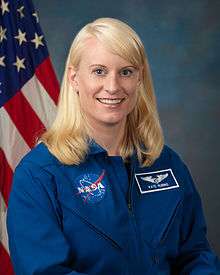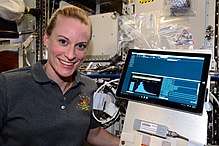Kathleen Rubins
| Kathleen Rubins | |
|---|---|
 | |
| NASA Astronaut | |
| Nationality | American |
| Status | Active |
| Born |
October 14, 1978 Farmington, Connecticut, U.S. |
Other occupation | Microbiologist |
Time in space | 115d 02h 22m |
| Selection | 2009 NASA Group 20 |
Total EVAs | 2 |
Total EVA time | 12 hours 46 minutes |
| Missions | Soyuz MS-01 (Expedition 48/49) |
Mission insignia |
|
Kathleen Hallisey "Kate" Rubins (born October 14, 1978) is a NASA astronaut.[1] She became the 60th woman to fly in space when she launched on a Soyuz spacecraft to the International Space Station on July 6, 2016.[2] She returned to Earth on October 30, 2016 aboard a Soyuz.[3] She was a crew member of Expedition 48 and Expedition 49 of the International Space Station.[3][4]
Personal life and education
Rubins was born in Farmington, Connecticut and raised in Napa, California, graduating from Vintage High School. Her father, Jim, still resides in Napa. Her mother, Ann Hallisey, lives in Davis, California.
She received a Bachelor of Science degree in molecular biology from the University of California, San Diego and a Ph.D. degree in cancer biology from Stanford University Medical School Biochemistry Department and Microbiology and Immunology Department. She was a member of the Kappa Lambda chapter of the Chi Omega sorority while attending UC San Diego.
Irish ancestry
Rubins' mother is Ann Hallisey who resides in Davis, California.[5] Her grandfather was William Bernard Hallisey of Aliquippa, Pennsylvania. Her great-grandfather was Patrick Hallisey, born in Clonakilty, County Cork, Ireland.[6]
Microbiology research
Rubins conducted her undergraduate research on HIV-1 integration in the Infectious Diseases Laboratory at the Salk Institute for Biological Studies. She analyzed the mechanism of HIV integration, including several studies of HIV-1 Integrase inhibitors and genome-wide analyses of HIV integration patterns into host genomic DNA. She obtained her Ph.D. from Stanford University and, with the U.S. Army Medical Research Institute of Infectious Diseases and the Centers for Disease Control and Prevention, Rubins and colleagues developed the first model of smallpox infection. She also developed a complete map of the poxvirus transcriptome and studied virus-host interactions using both in-vitro and animal model systems.
Rubins accepted a Fellow/Principal Investigator position at the Whitehead Institute for Biomedical Research (MIT/Cambridge, Massachusetts) and headed a lab of researchers studying viral diseases that primarily affect Central and West Africa. Work in the Rubins Lab focused on poxviruses and host-pathogen interaction as well as viral mechanisms for regulating host cell mRNA transcription, translation and decay.[7] In addition, she conducted research on transcriptome and genome sequencing of filoviruses (Ebola and Marburg) and Arenaviruses (Lassa Fever) and collaborative projects with the U.S. Army to develop therapies for Ebola and Lassa viruses.
NASA career

_Kate_Rubins.jpg)
Rubins was selected in July 2009 as one of 14 members of NASA Astronaut Group 20. She graduated from Astronaut Candidate Training where her training included International Space Station (ISS) systems, Extravehicular Activity (EVA), robotics, physiological training, T-38 flight training and water and wilderness survival training. Rubins was selected as a flight engineer for ISS Expedition 48/49. She became the 60th woman in space when she launched on Soyuz MS-01 in July 2016.[8][9][10][11]
In August 2016, Rubins became the first person to sequence DNA in space.[12] Aboard the ISS, she used a hand-held, USB-powered DNA sequencer called the MinION made by Oxford Nanopore Technologies to determine the DNA sequences of mouse, E. coli bacteria, and lambda phage virus.[13][14] It was a part of the Biomolecule Sequencer experiment, the goal of which was "to provide evidence that DNA sequencing in space is possible, which holds the potential to enable the identification of microorganisms, monitor changes in microbes and humans in response to spaceflight, and possibly aid in the detection of DNA-based life elsewhere in the universe."[15]
Expedition 48/49
Rubins returned to Earth on October 30, 2016 after 115 total days in space,[3] having served as flight engineer on Expedition 48 and Expedition 49 of the International Space Station.[3][16] This included the period from July to October 2016, and she had the role of flight engineer. In addition to biological research, she spent 12 hours and 46 minutes outside the station on two separate spacewalks.[16]
See also
References
![]()
- ↑ NASA HQ (June 29, 2009). "NASA Selects New Astronauts for Future Space Exploration". NASA. Retrieved June 29, 2009.
- ↑ "Station-Bound NASA Astronaut is the 60th Woman to Fly into Space". SPACE.com. Retrieved 7 July 2016.
- 1 2 3 4 Cofield, Calla (October 30, 2016). "Soyuz Space Capsule Lands Safely with Crew of 3". Space.com. Retrieved 25 April 2017.
- ↑ Whiting, Melanie (21 February 2016). "Kathleen "Kate" Rubins (PH.D.) NASA Astronaut". Retrieved September 14, 2018.
- ↑ http://www.jsc.nasa.gov/Bios/htmlbios/rubins-k.pdf NASA Bio, Kate Rubins
- ↑ "Log into Facebook - Facebook". Retrieved 25 April 2017.
- ↑ "Vaccinia Virus Infection & Temporal Analysis of Virus Gene Expression". JoVE. Retrieved March 17, 2013.
- ↑ "NASA Biographical Data - Kathleen (Kate) Rubins (Ph.D.)". NASA. Retrieved March 17, 2013.
- ↑ "NASA - In Their Own Words: Kathleen (Kate) Rubins". NASA. Retrieved March 17, 2013.
- ↑ Garcia, Mark. "Future Expeditions". NASA. Retrieved 2016-03-09.
- ↑ Yune, Howard (2016-06-01). "Napa-raised astronaut ready for launch to space station". Napa Valley Register. Retrieved 2016-06-01.
- ↑ Robbins, Gary (August 29, 2016). "UCSD alumna first to sequence DNA in space". The San Diego Union-Tribune. Retrieved October 26, 2016.
- ↑ Gaskill, Melissa (August 29, 2016). "First DNA Sequencing in Space a Game Changer". NASA. Retrieved October 26, 2016.
- ↑ Dance, Amber (October 19, 2016). "DNA Sequencing in the Final Frontier". BioTechniques. Retrieved October 26, 2016.
- ↑ Dunn, Andrea (September 29, 2015). "Sequencing DNA in the Palm of Your Hand". NASA. Retrieved October 26, 2016.
- 1 2 "Kathleen "Kate" Rubins (PH.D.) NASA Astronaut". NASA. Retrieved 20 April 2017.
External links
| Wikimedia Commons has media related to Kathleen Rubins. |